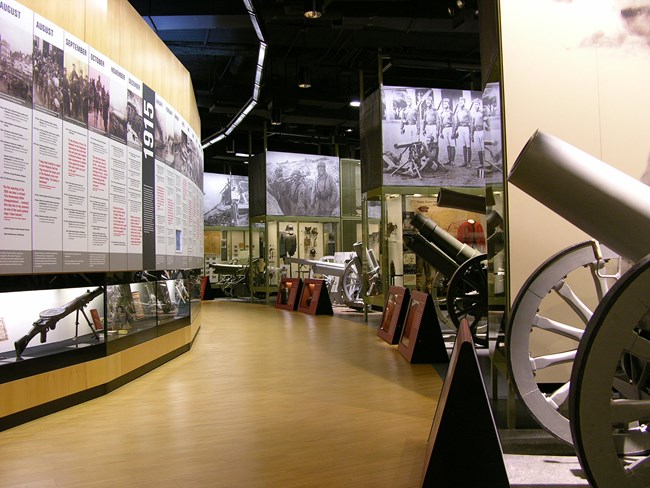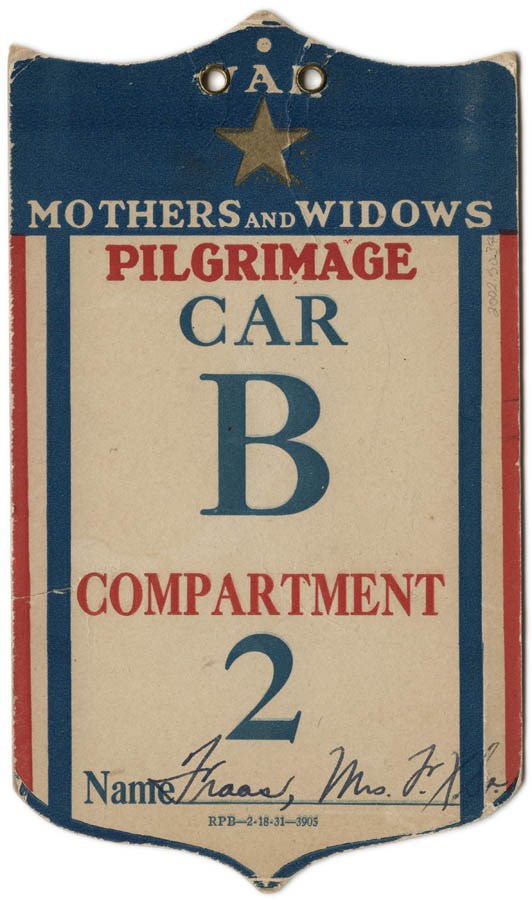Last updated: July 15, 2023
Article
Podcast 107: "Why Keep That?" Examining WWI through Memorabilia

Photo courtesy of the National WWI Museum and Memorial.

Photo courtesy of the National WWI Museum and Memorial.
WWI Museum and Memorial
Dr. Catherine Cooper: My name's Dr. Catherine Cooper, Research Scientist at NCPTT. Today, I'm speaking with Stacie Petersen, Director of Exhibitions and Registrar at the National WWI Museum and Memorial in Kansas City, Missouri, about the “Why Keep That?” exhibit. Stacie, welcome. Thank you so much for joining us.
Stacie Petersen: Yeah. Thank you so much for having me today.
Dr. Catherine Cooper: Could you tell us about the WWI Museum and Memorial and your role there?
Stacie Petersen: Yeah, so we are located in Kansas City, Missouri in the downtown area, so right across from Union Station next to Crown Center, the international headquarters for Hallmark. And our groundbreaking actually was a hundred years ago this month. We broke ground in 1921 and opened to the public in our original form in 1926. So we are the only collecting institution in the world looking at the global story of World War I. We are kind of beat out a little bit by the Imperial War Museums over in London, but of course they got into the war a couple years ahead of us. And they just had across the English Channel, while we had an ocean and half a continent.
Stacie Petersen: I am Director of Exhibitions and Registrar, so that's really kind of two sides of my job. As Director of Exhibitions, I oversee the logistics and the schedule for the museum's exhibitions. So that includes concepts, the work of bringing in contractors, construction, installation, basically bringing it to the public. The Registrar side is working with the collection itself: digitizing it, making it accessible to the world on our online collections database, as well as paperwork, things like loans, insurance, shipping, customs, those sort of things.

Photo courtesy of the National WWI Museum and Memorial.
“Why Keep That?”
Stacie Petersen: “Why Keep That?” is an exhibit that looks at what our museum collects and why we're keeping those sort of things. Because as you're going through the exhibit, you'll see different items, like menus and receipts. Really, when you think of military, of World War I, you're thinking of our large items, such as our guns and uniforms and machine guns and those larger objects. While within archives, it's a very diverse situation in terms of what is kept, because of course the story of World War I is more than just the military aspect.
![Barometric Chart of Feelings in England, 1914-1918 [2019.114.0] Photo courtesy of the National WWI Museum and Memorial. Barometric Chart of Feelings in England, 1914-1918 [2019.114.0] Photo courtesy of the National WWI Museum and Memorial.](/articles/000/images/2019_1_1.jpg?maxwidth=650&autorotate=false)
Photo courtesy of the National WWI Museum and Memorial.
Unique objects to tell multiple stories
Stacie Petersen: You also have the lives of those soldiers and service volunteers and service women that served and they went on tours. So we have tickets from train rides out when they were on leave and menus from different concerts they've gone to or programs and events like that. So with “Why Keep That?”, it was looking at, again, why are we keeping these objects? And what is the process of making the determination of bringing them into the Museum and Memorial's collection? We went through our collection and went, "Okay, what is unique? What is something that someone will look at and be like, 'So I am no longer a hoarder because I keep that sort of thing as well. And if the museum can keep it, I can now keep it as well'." So again, going back to those very day-to-day situations of maybe scraps of paper that they've sketched a prosthetic medical device on in order to support a limb, or tickets, memos. We have other unique things, like this huge chart that's called the Barometer Chart of Feelings that was produced by a woman in England, looking at her emotional wellbeing during the war. And it's literally a graph barometer chart of her highs and lows throughout the entire experience of World War I.
![Layout of field equipment. [2016.127.15] Photo courtesy of the National WWI Museum and Memorial. Layout of field equipment.](/articles/000/images/2016_7.jpg?maxwidth=650&autorotate=false)
Photo courtesy of the National WWI Museum and Memorial.
Ephemera
Stacie Petersen: This exhibition really is strongly pulled from our ephemera collection. So typically what we catalog as ephemera is all those little things that people collect as mementos of remembrance. So within this exhibition, we're looking at those mementos. So it might be a birthing ticket that shows, "This is the hammock I slept in on the ship ride over." Or also in that same frame is a birthing ticket of a Gold Star Mother who went on pilgrimage overseas. And you see two very distinct cards, because the hammock, very basic. It's like “Hammock B, tier three”, this is where you go. It's a piece of cardboard. While the birthing ticket for the Gold Star Mother is shaped, it has a hard ring for the hole so you could put it on a string. It's very decorative on front and back. So it was created to be a memento to keep.
Dr. Catherine Cooper: This sounds quite a bit like what you would see in scrapbooks. Are these loose objects or were they in collections?
Stacie Petersen: So in this particular case, these were all loose objects. They were things that we did not have to remove from photo albums or scrapbooks. Now, when objects come into our collection, while we say we have 3D objects and archives, the archives is not what we would consider your stereotypical archive. Really our archival collection is housed and stored more similar to a museum collection. So every piece of paper gets an accession number or object ID number. It's cataloged down to that level because of how our collection is used. So these are objects that you would see in a scrapbook, but luckily for us, they were not inside one.
Dr. Catherine Cooper: So you've mentioned that this has been a collecting museum for a hundred years now, essentially. Has the collection protocol changed since the inception?

Photo courtesy of the National WWI Museum and Memorial.
Collecting pieces of history
Stacie Petersen: So we have been collecting for a hundred years, and our shift really for the most part has not changed because our focus has always been World War I. So luckily for us, we've been very defined in that period of 1914 through 1919, 1921 and a smattering of select years after that, depending upon what was happening, such as the Gold Star Mother Pilgrimages, which happened later in the twenties into early thirties. And of course that's lucky for us, because we don't have this willy-nilly collection. But now, our focus has shifted a bit in that we have to be now a lot more selective. We have a lot of uniforms. So if someone wants to donate their grandfather's uniform and he was a private in the Army, more than likely, that's not something that we need to add to the collection because we already have other examples of that.
Stacie Petersen: But at the same time, this means we can now focus our energy on collecting more specific areas in terms of 3D objects. So we're looking at women's service, especially women Marines, and collecting initiatives of people of color, African Americans, Native Americans, anyone that served within those entities. But also looking at the Indigenous populations of Europe, Australia. So expanding our focus from just the general service man to more of those global participants that are not widely represented in our collection at this time.
Dr. Catherine Cooper: And does the collection also expand outward from not only the people actively participating in the war, but the people who were affected by it at home during those years?
Stacie Petersen: We include some of those stories of the homefront. And of course when we say homefront, a lot of people think, "Oh, United States," because that's where we are. But of course homefront expands to also Germany, France, Belgium, because those were the homefronts of the foreign entities that weren't involved in the war. So we do collect as much as we can of their stories as well. And in some cases, they might be told through the eyes of someone we have in our collection. For example, off the top of my head, I can think of a gentleman, his name is Arthur Standing. He was a conscientious objector, so he didn't fight in the war, but he was sent overseas to serve as a volunteer and he worked a lot in those French villages. So we have a scrapbook and mementos of his that tell their story through his lens though.
![Poster of African American stevedores unloading ships in France. [2011.65.1] Photo courtesy of the National WWI Museum and Memorial. Poster of African American stevedores unloading ships in France. [2011.65.1] Photo courtesy of the National WWI Museum and Memorial.](/articles/000/images/2011_3.jpg?maxwidth=650&autorotate=false)
Photo courtesy of the National WWI Museum and Memorial.
Suprising objects
Dr. Catherine Cooper: Is there anything in particular that surprised you in people interacting with this new exhibit?
Stacie Petersen: The one object I can think of in particular is a poster that's featuring African American Stevedores. And it is one of our examples of showcasing African American servicemen in a positive light. The imagery in it is reflective of service, of their work. And a lot of people see that and think, "Oh, that's not stereotyped to what you would see of imagery from the teens of people of color." So a lot of people are surprised by that, but they're also surprised by how we gathered that into our collection. It was not actually what we had originally intended to take. We took the rest of the collection that had been donated to us and this poster was found folded up in the back of a scrapbook. And as we were going through the collection and processing it, we found it folded up, unfolded it and went, "Whoa."
Stacie Petersen: And it's also a poster that I've, at least so far online, have only found one other example of at the New York Public Library. And we have a copy that was signed by the artist, including a letter that was talking about how he created it and why he created it. There's a few examples on our website underneath the exhibition page, but this is all available via our online collections database at our website, which is theworldwar.org. If you don't have an interest in World War I now, I challenge you to do a study of World War I and try to find something that's not of interest. There's so much that can be traced back to the history of World War I. So the Civil Rights Movements, the Suffragette Movement, daylight savings times, we just all went through that, can be traced back there. Even if you wear a trench coat in your daily life now here in the fall, that comes out of World War I, as well as even the technology that's running your cell phone. So there's a story in line that can interest nearly everyone in World War I.
Dr. Catherine Cooper: Thank you so much for taking the time to talk to us today. I hope that folks will come visit you, either in person or virtually.
Stacie Petersen: Yeah, we are open now and through Memorial Day, every Tuesday through Sunday. And between Memorial Day and Labor Day, we're open seven days a week.
Read other Preservation Technology Podcast articles or learn more about the National Center for Preservation Technology and Training.
